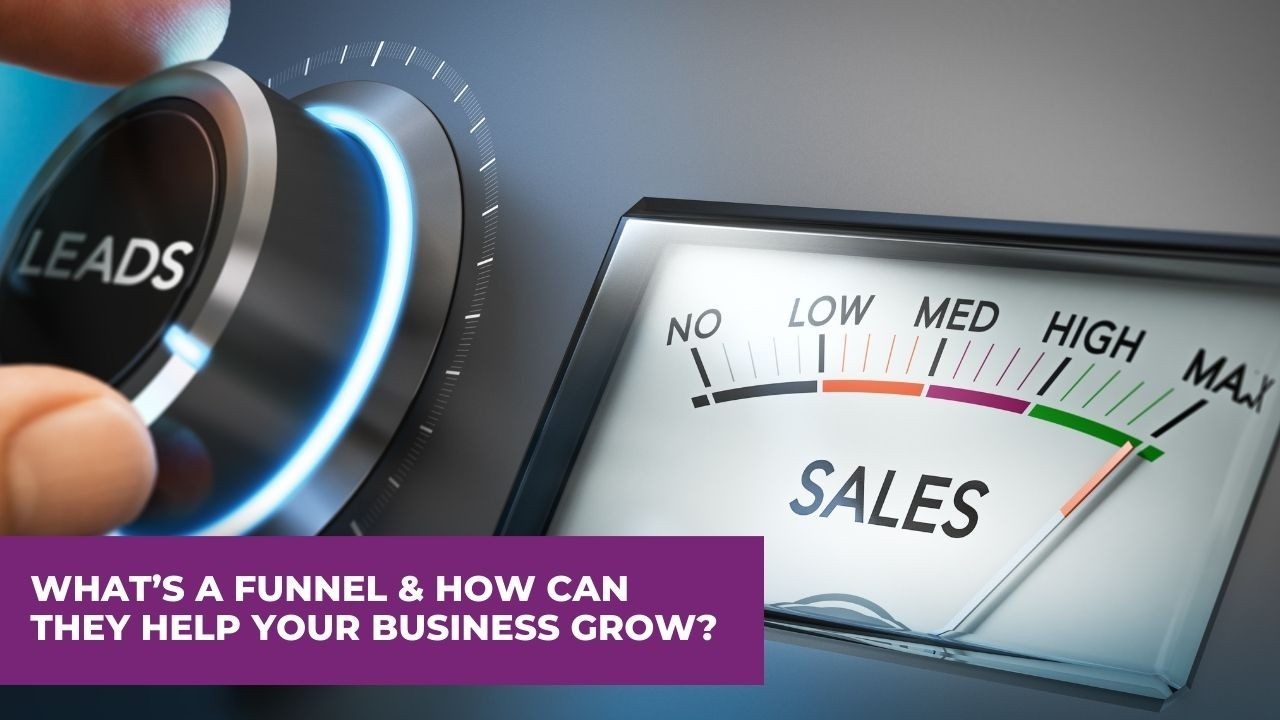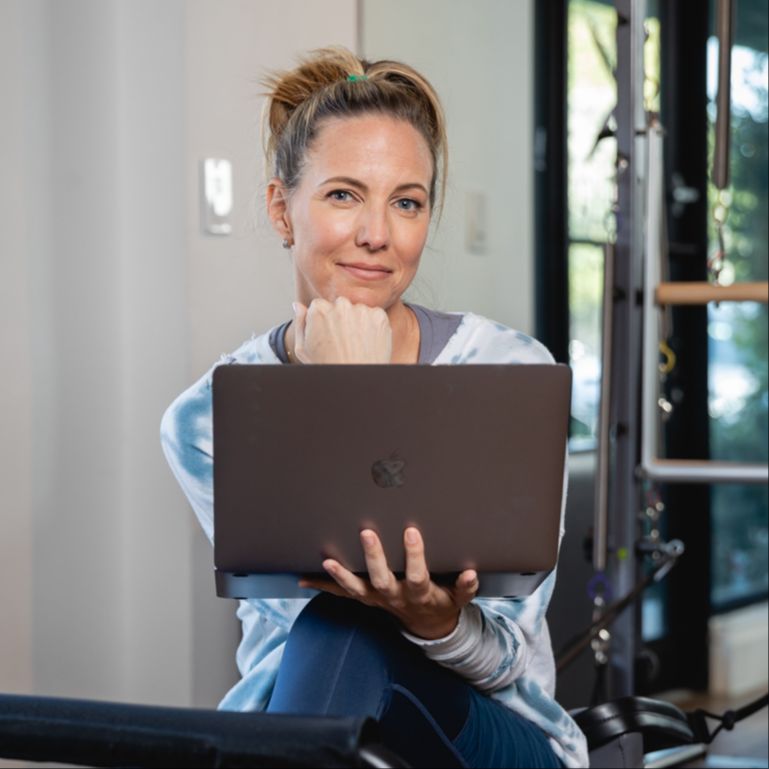What’s a Funnel & How Can They Help Your Business Grow?
Mar 24, 2021
What turns someone into a raving fan… if they’ve never met you before. On a recent episode of Female emPOWERED, that’s exactly what Michelle Fernandez and I chatted about! Michelle is actually my personal Facebook ads and funnel expert — and she helps both my personal coaching brand and my Pilates studio locations get more people interested in them.
How does she do that? Through funnels. I highly recommend listening to the full episode here, but I recap what we talk about in the blog below!
So… what is a funnel?
It’s in two parts:
1. Marketing, i.e. building awareness, driving traffic, etc.
2. Sales, i.e. the path a customer takes to purchase — from interested to purchase
Every business has a sales funnel, because you have to sell to someone to have a business. Even if you’re new, you’ve got a sales funnel. Think about the referral you just got, how you hopped on a call or met them in-person, and then booked them. That’s a sales funnel! Of course, sales funnels can be more robust and “professional” than that.
Funnels tend to be really popular in the online space, because you can create freebies or opt-ins, build sales pages, or have people book directly from your site. But people with brick-and-mortar businesses can use them, too! Think about billboards — those are part of your funnel. Word of mouth is, too!
The key to starting a sales funnel is to just create a connection. Find something that has them saying, “Me, too!” Or “Hey that person gets it,” or “I like the way this business talks about this problem.” Once you get them in your door (literally or online), it’s all about how you sell to them and get them to come back.
A great way to continue that connection, or to start it in the first place, is through Facebook ads.
Want to try Facebook ads? Start at the end
If you’ve ever thrown a few bucks behind a Facebook ad, or started an ad strategy with a company, you know that it can feel like you’re throwing money at something doesn’t work. But as Michelle explains, the job of a Facebook ad isn’t necessarily to get you a sale (sometimes, sure, but not if you’re just starting out!). It’s to get you a lead.
What you do with that lead is what matters — and that’s what happens outside of Facebook. The ad can only do so much.
That’s why Michelle recommends that you start with your ultimate goal and then work backward from there when deciding what sort of ad to create.
Think about the ultimate transformation you want to offer people, if you’re a health or wellness pro. Is it to relieve back pain? Is it to serve your community with a thriving yoga studio? Name your goal.
Moving backward from there — let’s say it’s to build a thriving yoga studio — your goal would be to get people in the door for a class. You know that if you get them in there, you can get them to come back. To get people in the door, your backward-facing goal might be to get more people visiting your website or downloading your free yoga guide.
That helps you decide what sort of Facebook ad you need to create, and the sort of conversion you’ll want to plan for.
Which type of Facebook ad you need to meet your goals
If you’re totally new to Facebook Ads Manager, there are different types of campaigns you can set: awareness, objective, and conversion. Essentially, do you want new audiences to hear your name for the first time? Do you want them to take a specific action (i.e. watch a video)? Or do you want them to purchase something?
Based on your backward goal breakdowns, this should tell you what kind of ad to create! From there, you’ll need to know which metrics to track… and what benchmarks you need to know if your ad works!
Metrics for your Facebook ads
Michelle talks about a number of ad metrics on this episode, but here are a handful of the most important ones:
- Cost per click: How much does it cost you when someone clicks your ad? (Average cost depends on what your ad goals are!)
- Cost per acquisition: If you’re running video view ads or something more about awareness, it can be really hard to track cost per acquisition — because you’re not technically acquiring a sale. That’s why it’s important to ask new customers where they heard about you, or how they came to your store. That will tell you where they had their first touchpoint, and can give you a better idea of your cost per acquisition based on how much you spent on the platform/tool they found you on.
- Cost per result: Depends on the type of result you want, i.e. video views.
- Click-through rate: You want this to be 1% or higher (2-5% is ideal). If it’s lower, you’re not sharing the right message to the right people. This means there’s probably something wrong with the ad itself.
- Landing page conversion: How many people click on your ad, visit the landing page, and buy/drop their email/convert in some way? You want this to be about 20 to 30%. If it’s under that, there’s a gap between the ad and landing page. Is something different? Does the messaging change? Does the link go to the right place?
- Video views: How long are people watching your video ads? Facebook “qualifies” people who watch more than 15 seconds, which means you know your leads are a lot stronger — they’re interested in what you have to say! You want about 25 to 50% of video views to be watching those 15 seconds, or the video might not be grabbing people’s attention.
- Earnings per lead: Take the total number of leads acquired, and the total amount of money earned, and divide money by leads. That’s your cost per lead and can show you if you’re getting ROI from your Facebook ad investment.
Another factor in the success of your Facebook ads? Time! You can’t just slap up an ad and expect sales in an hour! Ads are a slower burn, and can take a couple of days to get into the right feeds. You also get more information the longer your ads run.
How to map out your Facebook ads goals and budget
So what does this look like in math? Let’s say we set a goal to have 30 people sign up for our On-Demand offer. We know that landing pages should convert at about 20% — which means we need to get at least 150 people clicking to that landing page. We know that about 2% of people will click through an ad, which means we’d need about 7,500 people to see the ad. That means we’d need to have a large enough audience — and budget — to get an ad viewed about 7,500 times (preferably more).
All of this sort of guides you on your metrics, and helps you see where you need to make tweaks or where things might not be working. It’s also important to remember that, even if a specific ad doesn’t convert the way you’re expecting (i.e. number of On-Demand packages sold), you’re still increasing brand awareness, possibly acquiring email addresses to sell to people in the future, and building a relationship that could be really profitable for you down the road.
It’s possible to have 7-figure launches with funnels and Facebook ads — Michelle has seen it. Keep reading to hear her best advice on making your funnels a success.
The most successful funnels have THIS
The best suggestion Michelle has for making funnels and using Facebook ads? Make sure your audience will have a cohesive experience. You want the Facebook ads to work well with your landing page, you want your free opt-ins to lead well into your paid offer, and you want any sort of marketing or sales funnel to flow well together. You don’t want to have a dozen different styles or messages on each part of the funnel — it needs to flow!
It’s also super important that you have a clear focus for your funnel, a single action people can take. Don’t give them a ton of options, and don’t let them navigate away once they’ve found your funnel!
Michelle also recommends that you keep your funnel offer — whether it’s a paid offer or a freebie — to one solution that focuses on one problem.
For example, we created a January New Years resolution challenge at Pilates in the Grove, because we knew that one of the biggest obstacles to sticking to a New Year’s resolution is feeling like you have to do all the things all the time and go super hard.
The truth is, people need some basic exercises, nutrition, and a reminder that they can do this. So we created a 10-day challenge for the New Year, and offered it to people via email. No classes, no fancy equipment. Just email inbox exercises and activities to help them start the year off right. We promoted it via social and email and ads, and people clicked on the landing page to drop their email. From there, they got a confirmation email, a reminder the challenge was coming up, and then 10 days of content right to their inbox. At the end, we sent them a few emails to let them know about our paid offers and to share a discount code.
That’s how a funnel works! Are you excited to give one a try, or to learn how you can CONNECT more with your audience?
Find your message, connect with your people
I hope you’ve read all of this with an open mind. I know it can feel overwhelming, but the truth is, a funnel can come together very quickly when you know your audience and the message that speaks to them.
Half the battle is knowing what message your people need to hear! That’s what I’m helping you do inside our Biz Building Bootcamp. If you want 30 days of actionable advice on honing in on your message, finding out how (and where) to connect with your audience, and creating a market plan that can help you build your funnels… this Bootcamp is for you!
In 30 days, you’ll get LIVE training and an impactful marketing plan that helps you connect to your ideal clients and patients so that you have a fully booked schedule of paying customers.
Join the waitlist for the Biz Building Bootcamp today!
Lorem ipsum dolor sit amet, consectetur adipiscing elit. Cras sed sapien quam. Sed dapibus est id enim facilisis, at posuere turpis adipiscing. Quisque sit amet dui dui.
Stay connected with news and updates!
Join our mailing list to receive the latest news and updates from our team.
Don't worry, your information will not be shared.
We hate SPAM. We will never sell your information, for any reason.



